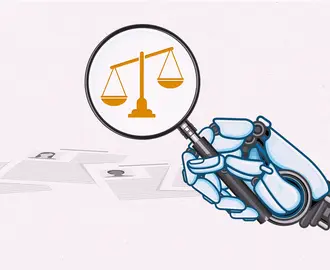Credit: Jennifer Tapias Derch
Data literacy — the ability of a company’s employees to understand and work with data to the appropriate degree — can be a stepping stone or a stumbling block when it comes to building a data-driven company.
A recent Gartner survey of chief data officers found that poor data literacy is one of the top three barriers in building strong data and analytics teams, while a data literacy survey by Accenture of more than 9,000 employees in a variety of roles found that only 21% were confident in their data literacy skills.
While there is work to do, data training is worth it. “In a world of more data, the companies with more data-literate people are the ones that are going to win,” said MIT Sloan senior lecturerwho teaches courses on communicating and persuading with data.
“Data literacy has always been a requirement in successful organizations. It's just that data illiteracy is more obvious now — or data illiteracy just causes more damage now than it used to,” Kazakoff said.
“Everybody needs data literacy, because data is everywhere,” said Piyanka Jain, a data science expert and author of “Behind Every Good Decision: How Anyone Can Use Business Analytics to Turn Data into Profitable Insight.” “Data is the new currency, it's the language of the business. We need to be able to speak that.”
Companies will need to find a path to data literacy for their workforce, which includes knowing why data literacy matters, what data literacy looks like for every employee (hint: it’s not one size fits all), and how to establish a baseline of employee skills and common data language.
Experts offered these tips for building a data-literate company.
Know what data literacy is — acknowledging that it’s different for everyone
MIT professor Catherine D’Ignazio and research scientist Rahul Bhargava describe data literacy in a paper as the ability to:
- read data, which means understanding what data is and the aspects of the world it represents.
- work with data, including creating, acquiring, cleaning, and managing it.
- analyze data, which involves filtering, sorting, aggregating, comparing, and performing other analytic operations on it.
- argue with data, which means using data to support a larger narrative that is intended to communicate some message or story to a particular audience.
In order to be data literate, “you have to be verbally literate, numerically literate, and graphically literate,” Kazakoff said.
“It’s a challenging skill set to build for organizations, because data literacy requires people to perform at a high level and master a set of foundational skills that haven't always been taught together.” In particular, graphical literacy — understanding data and data visualization — is relatively new, Kazakoff said. “You can't assume all that training has been part of people's formal education.”
In a survey of more than 9,000 employees in a variety of roles, 21% were confident in their data literacy skills.
Data literacy also means being able to go beyond analysis and effectively communicate about data with others. “Saying data literacy is just about the analysis and not about the communication is like saying that literacy is just about reading and not about writing,” he said. “Literate people can both read and write.”
But not everyone in an organization needs to become a data scientist. Different roles at different companies require varying levels of data literacy.
“Data literacy is not one size fits all,” Jain said. “Data literacy is, ‘Do you have the right level of literacy in the role that you are serving?’”
Jain’s data science and data literacy consultancy, Aryng, identifies different levels of literacy, from a data skeptic, who might ignore data — you probably don’t want skeptics in your organization, Jain said — to data enthusiasts, who are eager to learn more about data but don’t have a depth of knowledge. Data literates are able to think and act with data, but aren’t as expert as data scientists.
“Everyone has to be able to read their business domain data and understand what it means and where it comes from,” said Cindi Howson, the chief data strategy officer at ThoughtSpot and host of The Data Chief podcast. But addressing higher-level issues like gaps or problems in the data or alternative data sources are higher-level issues, she said. “Not everyone in the organization needs to be that fluent.”
Know why you need it
Data literacy has become more important as companies have more and more data available and the technology to be able to analyze it. While in the past companies might have had a few skilled data professionals on staff, now almost everyone needs to have some level of awareness.
The volume of data is a big reason for emphasizing data literacy, Kazakoff said. A subtler reason is that as more things get automated, the tasks humans do often require judgment, which is improved by data literacy.
“Data-literate people make better decisions,” he said. “What's changed is that companies need decision-makers to make better decisions faster than ever before. That requires more people to be data-literate.”
“It’s about empowering the new decision-makers, which are the frontline workers,” Howson said. In a restaurant, that might be a server armed with customer-preference data. “If you wanted that chocolate cake and it's sold out, what's the next most popular item? Maybe that is the cheesecake.”
A recent report from ThoughtSpot and the Harvard Business Review found that successful companies are enabling frontline workers, like customer service representatives and delivery and repair workers, with better data and insights to make good decisions. When workers have that information, the report found, companies have higher rates of customer and employee satisfaction and higher productivity and top-line growth.
Create a data literacy plan
There’s no single way to establish data literacy, but experts recommend a few key steps.
Jain said her company, which has worked with organizations including Google, Comcast, and Regeneron, has a three-step framework: defining data literacy goals, assessing employees’ current skill levels, and laying out appropriate learning paths.
Howson recommended a similar approach. “Develop an assessment, develop the program, agree on desired levels, and then implement a plan of action,” she said.
Data literacy programs should be sure to:
1. Distinguish between data literacy and technical literacy.
Businesses have spent too much time training people on hard-to-use technical tools instead of emphasizing data, Howson said. “If we're spending 80% now on technology, 20% on data, flip it — make the technology super easy so that you can spend more time on data.”
2. Start with a baseline of employee skills.
Building data literacy starts with knowing existing skills and agreeing on the level of proficiency for different job types, Howson said. From there, companies can develop a plan for how to upskill workers.
When Aryng works with companies, employees take a data literacy assessment to establish their skill level as part of an analytics maturity assessment.
3. Use common language.
Related Articles
Using jargon or imprecise terms can create confusion and complicate communication about data.
“Establish a common way of talking about data throughout the organization,” Jain said —for example, analysts collaborating with marketers might work on a project to optimize ROAS (return on ad spend), but if the marketers don’t understand the term, they might not end up using the best insights.
“Establishing that common vernacular is very important to establishing a culture of data,” Jain said. “It's basically a civilization and its language. If you don't have language, civilizations don't work.”
4. Build a culture of learning and reward curiosity.
Leaders should make sure to foster an environment that rewards curiosity instead of punishing lack of data literacy. “If there is a culture of fear rather than of continuous learning and improvement, then people would feel ashamed that they're not data-literate,” Howson said. “Nobody wants to feel dumb. So there has to be a culture of continuous learning where curiosity is rewarded.”
Similarly, if data reveals something negative, it shouldn’t necessarily be used to punish employees, she said. “Confront the brutal facts of the negative data and learn from it. If punishment is the first reaction, then people will try to hide the data or manipulate it – vanity metrics. That’s another aspect of the culture I think is important.”
5. Remember that everyone learns differently.
Not everyone is suited to a three-hour training classes — some employees learn best with hands-on exercises, while others might like self-led courses. “Not everyone learns the same way, so building those workshops, skills, or enablement has to be continuous and right-sized, and [in] the right medium,” Howson said.
6. Define success.
Without metrics to gauge success, it’s hard to know if data literacy initiatives are successful. Jain said her company pairs literacy training with hands-on, high-value projects with measurable performance indicators. “If you don't think about success metrics, you're not going to get the results,” she said.
This frames data literacy as not just a good skill to have, but something that drives results. “I think the biggest mistake organizations do is that they don't think of the power of data literacy. That project can really drive millions of dollars for you right away,” Jain said. “I highly recommend tying it to real projects, real things on your workflow, that drives real results.”
New executive education: Persuading with Data
7. Make sure leaders are involved.
Data experts said chief data officers are often the ones in charge of literacy initiatives, but all top executives needs to be on board and modeling the desired results.
“If you're not going to be able to be data-driven and holding your team accountable from the top, it's not going to flow down,” Jain said. “Leadership is the key. Data literacy projects shouldn’t be launched without executives being part of the program.”
8. Know that data literacy alone isn’t enough.
Many leaders have the misperception that data literacy is a long journey, Jain said, but measurable progress can be made in a year.
But even though results can come relatively quickly, data literacy isn’t the only part of becoming a data-driven company, Jain said. It’s a piece of a larger picture that also includes data maturity — that is, easy access throughout the organization to good data; data-driven leadership — meaning that leaders demonstrate the skills they require of workers; and finally, the ultimate goal — data-driven decision-making.
While data literacy has become a big keyword, other things need to come together for a data culture. “True data literacy should enable one to think and act differently — start by understanding the real business problem and use intelligent insights to solve the right problems,” she said.
Read next: How to build a data analytics dream team



